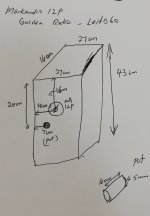I have made box in golden ratio. 17 - 18 liter is the volume.
Inside is the high 43 cm w 27 cm d 16 cm. 1.61/ 1.0 / 0.61 ratio. The golden ratio for no resonas.
I am happy for is very clean and sound like magic.
F3 is 55 Hz .
Inside is the high 43 cm w 27 cm d 16 cm. 1.61/ 1.0 / 0.61 ratio. The golden ratio for no resonas.
I am happy for is very clean and sound like magic.
F3 is 55 Hz .
Last edited:
I too have the 12P drivers but in an open baffle design, roughly based on the OBL-15. Yes they sound like "magic" but due to my room acoustics I'm thinking of putting them in an enclosure.
Tell us more about the box you made for yours - is it sealed, ported, how much and what dampening material?
Thanks
Tell us more about the box you made for yours - is it sealed, ported, how much and what dampening material?
Thanks
IT is ported. I have damping inside rearside with 2-3 cm and same left right and up and down. It is wool.
Port 1. Diam 45 mm and 60 mm long.
12 p have i placed 16 cm from upside. 14 cm from left side.
The port is placed 7 cm from left side and 20 cm from upside. It is placed same side as p12. In front.
Mirror left and right speaker.
Port 1. Diam 45 mm and 60 mm long.
12 p have i placed 16 cm from upside. 14 cm from left side.
The port is placed 7 cm from left side and 20 cm from upside. It is placed same side as p12. In front.
Mirror left and right speaker.
Last edited:
For those wishing to experiment with the Golden Ratio:
How to obtain the 'Golden Ratio' dimensions of a loudspeaker enclosure
1. Width (in cm) equals the cube root of the enclosure volume (in millilitres).
2. Height equals width multiplied by 1.612.
3. Depth equals width divided by 1.612.
How to obtain the 'Golden Ratio' dimensions of a loudspeaker enclosure
1. Width (in cm) equals the cube root of the enclosure volume (in millilitres).
2. Height equals width multiplied by 1.612.
3. Depth equals width divided by 1.612.
Neat - the online calculator must use the same maths as I do! 😉
But handy to know - I've bookmarked it - thanks for bringing it to my attention.
But handy to know - I've bookmarked it - thanks for bringing it to my attention.
Zman01
I have several amp to choose. Now i use Copland pre amp and Acoustic Reality class D monoamp.
Speakers is not ready yet. They are raw finish.
I have several amp to choose. Now i use Copland pre amp and Acoustic Reality class D monoamp.
Speakers is not ready yet. They are raw finish.
Last edited:
Zman01
I have several amp to choose. Now i use Copland pre amp and Acoustic Reality class D monoamp.
Speakers is not ready yet. They are raw finish.
Noted LeifB60, and good luck with the finish - I am sure the speakers will look good once you've completed them.
I have tried pensil and händel but ratio version beat them all.
The sound is the best.
Thanks for share your work
Is there a link for Handel speaker?
I have 14 cm from upside to A12p.
Port is placed 32 cm from upside.
That is inside the Box.
I have 16 mm mdf board.
Port is placed 32 cm from upside.
That is inside the Box.
I have 16 mm mdf board.
It was Thiele who was largely responsible for popularising golden ratio for speaker cabinets back in the early - mid '70s. Nominally it spreads the eigenmodes (it does not prevent their existence), but pretty much any irrational number basis can be used as an alternative. It just happens to the best known one from architecture &c. It can be applied internally or externally to a sealed or vented box. Far from being a 'magic bullet' and it doesn't generally make a massive difference unless directly compared to something very bad, but assuming you don't sacrifice something more useful simply to achieve it, it's worth doing (or using an alternative acoustic / irrational based ratio), especially for larger cabinets.
Last edited:
It was Thiele who was largely responsible for popularising golden ratio for speaker cabinets back in the early - mid '70s. Nominally it spreads the eigenmodes (it does not prevent their existence), but pretty much any irrational number basis can be used as an alternative. It just happens to the best known one from architecture &c. It can be applied internally or externally to a sealed or vented box. Far from being a 'magic bullet' and it doesn't generally make a massive difference unless directly compared to something very bad, but assuming you don't sacrifice something more useful simply to achieve it, it's worth doing (or using an alternative acoustic / irrational based ratio), especially for larger cabinets.
Thanks Scott,
It’s always good for a complete novice to read an explanation of these things.
- Home
- Loudspeakers
- Full Range
- Alpair 12P
